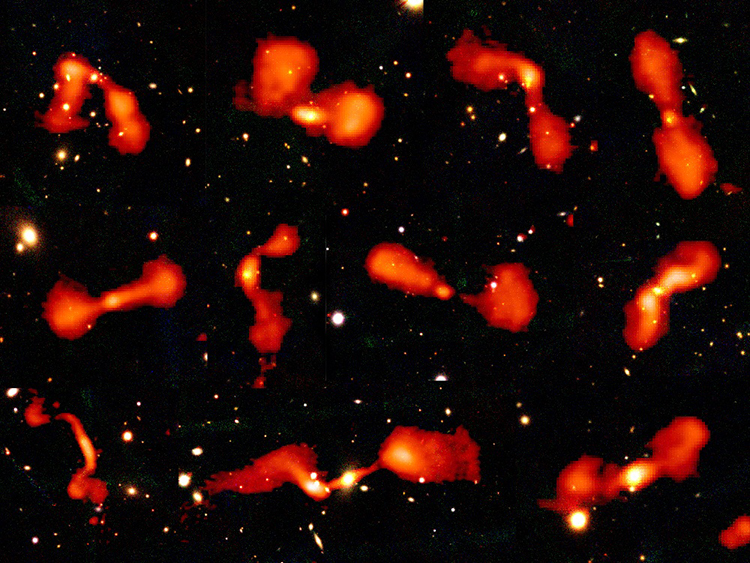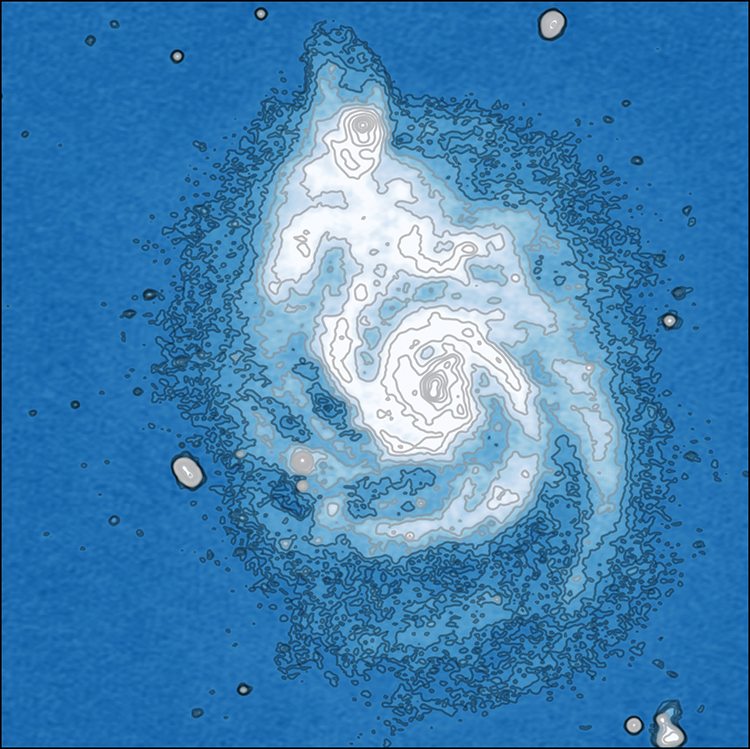UCD team helps redraw map of the Universe as almost 300,000 new galaxies discovered
Posted 19 February, 2019

Glimpses of low-power radio galaxies from the HETDEX region Credit: Judith Croston/LOFAR surveys team
- Almost 300,000 previously undetected galaxies have been revealed as part of a major new survey.
- More than 200 astronomers from 18 countries worked on the project, including two reseachers from UCD.
- The scientific journal Astronomy & Astrophysics has dedicated a special issue to the group’s findings.
An international team of astronomers, including researchers from University College Dublin, have uncovered hundreds of thousands of previously unseen galaxies.
More than 200 astronomers from 18 countries have published the first phase of a major new survey using the (opens in a new window)Low Frequency Array (LOFAR) telescope.
Scanning the sky for low frequency radio waves, the researchers were able to detect the emissions of massive black holes, which are usually found at the centre of galaxies, and reveal almost 300,000 previously undetected galaxies.
The data sheds new light on many research areas including the physics of black holes and how clusters of galaxies evolve.
(opens in a new window)Associate Professor John Quinn, UCD School of Physics and his PhD student, Sean Mooney, who is supported through an Irish Research Council Government of Ireland Postgraduate Scholarship, are members of the LOFAR survey project.
They are lead authors on a (opens in a new window)paper published in the scientific journal (opens in a new window)Astronomy & Astrophysics, which has dedicated a special issue to the group’s findings.
(opens in a new window)Their paper is one of 26 featured in the (opens in a new window)latest edition of the journal, and focuses on the jets from supermassive black holes that are pointed towards the Earth.
“The LOFAR survey provides us with an unprecedented view of galaxies with supermassive black holes at their centres, and how they evolve,” said Associate Professor John Quinn.
“The sensitivity and resolution of this LOFAR survey is unparalleled at low frequencies, and the technological advancements required to make this possible are relatively recent.”
UCD PhD student Sean Mooney added: “We’re interested in studying high-speed jets of plasma that are ejected from supermassive black holes, and the survey is a goldmine of information for us.
“Now that the data are public, it will surely prove to be a useful resource for many other astrophysicists around the world also.”

The spiral galaxy M51 in the HETDEX region Credit: Tim Shimwell/LOFAR surveys team
So far, the LOFAR telescope survey has chartered only one quarter of the night sky in Earth’s northern hemisphere at low frequencies, with 10% of the data being made public at this point in time.
It mapped three hundred thousand sources, almost all of which are galaxies spread across the Universe; their radio signals having travelled billions of light years to reach Earth.
Professor Huub Röttgering, Leiden University, and principal investigator of the surveys team said: “If we take a radio telescope and we look up at the sky, we see mainly emission from the immediate environment of massive black holes. With LOFAR we hope to answer the fascinating question: where do those black holes come from?”
"What we do know is that black holes are pretty messy eaters. When gas falls onto them they emit jets of material that can be seen at radio wavelengths.”
Big sky survey by (opens in a new window)@LOFAR has detected hundreds of thousands of previously undetected galaxies, shedding new light on black holes & how clusters of galaxies evolve. The first 26 articles have just been published in (opens in a new window)@AandA_journal (opens in a new window)https://t.co/IMNbORFIqf (opens in a new window)pic.twitter.com/RTHoj50Mun
— ASTRON (@ASTRON_NL) (opens in a new window)February 19, 2019
Creating low-frequency radio sky maps requires significant computational resources.
Machine learning algorithms are being used to automate parts of the analysis, with some of this work being done at UCD on powerful computing clusters.
“It is the largest astronomical data collection in the world, [so] processing the enormous data sets is a huge challenge for scientists,” said Dr Raymond Oonk, SURFsara, a member of the international team of researchers.
“What normally would have taken centuries on a regular computer was processed in less than one year using the high throughput compute cluster (Grid) and expertise.
The international LOFAR telescope consists of a European network of radio antennas, connected by a high-speed fibre-optic network spanning seven countries.
The system is operated by ASTRON (Netherlands Institute for Radio Astronomy), with its core located in Exloo in the Netherlands.
The Irish station was installed in the grounds of Birr Castle, Co. Offaly in 2017, with support from Science Foundation Ireland, Enterprise Ireland, the Department of Business, Enterprise, and Innovation, Offaly County Council, the Department of Culture, Heritage, and Gaeltacht, UCD, TCD, Armagh Observatory, DCU, UCC, NUIG, DIAS, and AIT.
By Staff Writers, UCD University Relations






